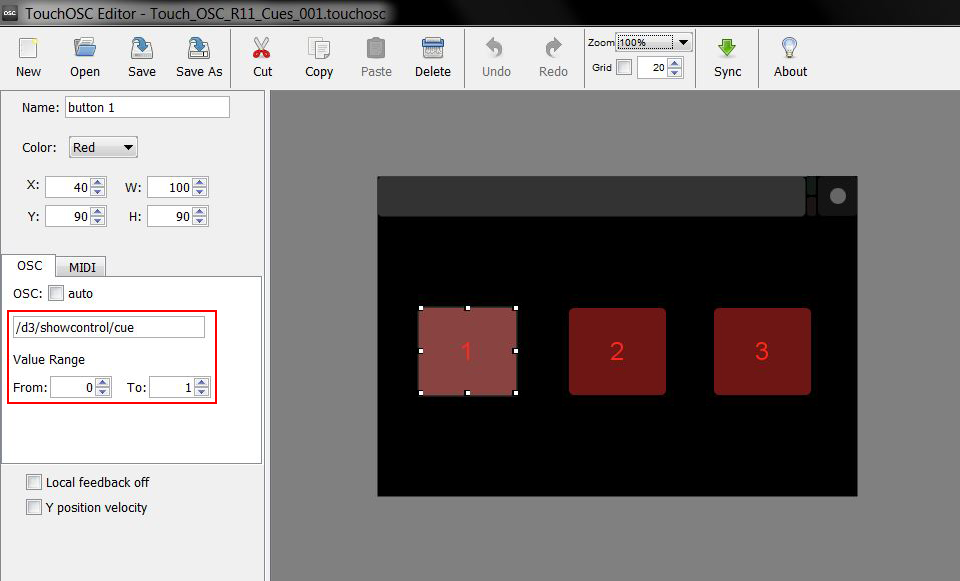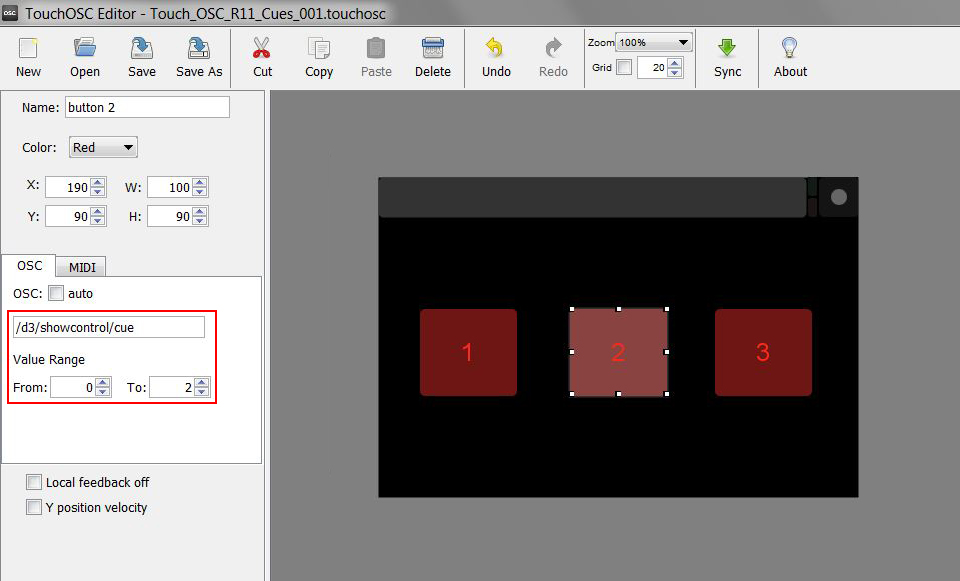Triggering cues with OSC
The track on the Timeline can have cues assigned to it, which can then be triggered by incoming OSC messages.
To trigger a track bar with OSC, first ensure Disguise software is setup with an OSC device and an OSC transport. To read more about OSC setup for Disguise, see the Configuring OSC Control page.
Create an OSC interface following the example below, which can be downloaded here. This was created in TouchOSC but any application capable of sending OSC is adequate, for example Lemur.
Please note: To open the TouchOSC interface, first run TouchOSC, then open the layout from inside the application.

The OSC layout above shows three buttons each having an assigned string and argument.
String: d3/showcontrol/
Arguments: button 1 sends a message with float values between 0 and 1, button 2 sends a message with float values between 0 and 2 (shown below), and button 3 sends a message with float values between 0 and 3.

TouchOSC layout with button 2 assigned values 0 and 2 as an argument.
Warning: Because TouchOSC sends a cue value of 0 when you release the button, it will cause Disguise to jump to CUE 0 on the track. This is a limitation of TouchOSC, the workaround being to not have CUE 0 assigned to the track.
Setup the Timeline to receive incoming OSC messages. Assign cues to the track following a format that matches the argument(s) being received. In the example below, three cues were assigned to a track, each corresponding to a different argument.
-
CUE 1will be triggered by an OSC message sending a single argument value of 1. -
CUE 2will be triggered by an OSC message sending a single argument value of 2. -
CUE 3will be triggered by an OSC message sending a single argument value of 3.
Cues assigned to a track on the Timeline following three different formats for receiving three different incoming OSC messages.
Please note: You can trigger cue x.y and x.y.z by sending a double or triple argument from a supported OSC system.
Use the string /d3/showcontrol/cue=%3,%4
This will send an OSC message with every cue of the integer and the float past the decimal point. So, cue 1.1 on the Eos will trigger cue 1.1 in disguise.
Please note: Disguise software understands cues as xx.yy, not xx.xx. This means that leading zeros are ignored (cue 1.1 and cue 1.01 both read as cue 1.1 inside Disguise software) Only in the last decimal point will this be an issue.
For more granular control, this can be changed to be /d3/showcontrol/cue=%2,%3,%4. That allows the first number to be cue list, second cue integer and third float. So cuelist 3 cue 4.5 will trigger cue tag 3.4.5
Please note: The arguments are separated by commas in the Eos output section, but are sent as period separated.
An OSC message from Qlab can hold multiple arguments, separated by a space. So in Qlab make a generic OSC cue and for it's string set it to /d3/showcontrol/cue 7 8 9 and this will trigger cue 7.8.9 inside Disguise software.
Please note: Qlab messages can have a varied number of arguments, Disguise software will only accept three or less.
